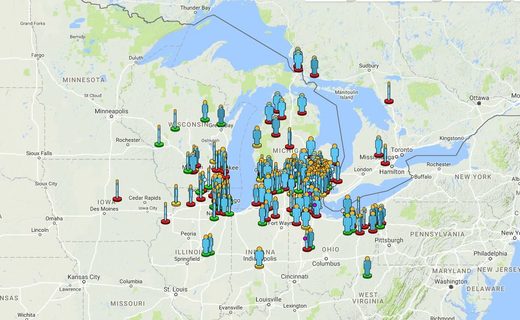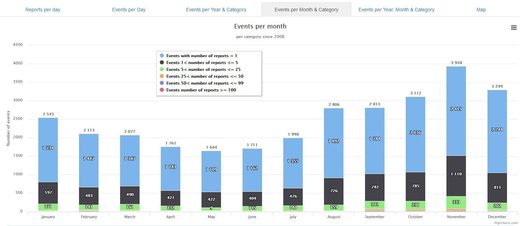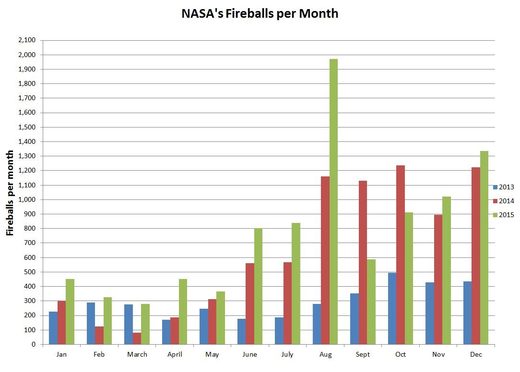PLANET X INCOMING: Michigan Meteor Event: Fireball Numbers Increased Again in 2017
This one was a little different than the 'regular' fireball events occurring globally these days: people across southern Michigan also heard a powerful boom that arrived about three minutes after the white-out, and the event even registered as a magnitude 2.0 earthquake on local seismographs.
Given its location, the event was likely seen by tens or hundreds of thousands of people. The American Meteor Society (AMS) has to date received 665 reports from eyewitnesses, along with dozens of great videos of the event.
Interestingly, observers in the Detroit area reported both a concurrent sound and a delayed boom about three minutes later. The delayed boom was probably the sound of the bolide exploding in the atmosphere, which takes time to travel down to the ground from high up in the atmosphere. As always happens, many reported the fireball being 'right overhead'. While partly true for anyone in southern Michigan that evening, its lowest altitude was nowhere near as close as it seemed (about 20 miles up, according to one estimate).
No matter the altitude of these events, however, eyewitnesses tend to freak out rather than 'wish upon a shooting star'. John Ellsworth, a police chief in the greater Detroit area, says his phone lit up with calls from residents wondering what had just happened, while he himself stated: "I have to say, when I first saw that, the thought crossed my mind that this was going to be the beginning of the end. It was that surreal." CBS Detroit also claimed that Ellsworth not only heard the boom, but "could also feel its impact, much like the force from an electronic jolt." Meteorites have since been found in Hamburg Township, located about half-way between Lansing and Detroit.
So that one was a biggie, but events just like it are happening with alarming frequency in recent years. As you might have noticed from watching our monthly video summaries of extreme weather (of both the terrestrial and cosmic kind), the frequency of meteor fireball events is on the rise. The American Meteor Society's Fireball Log data provides a graphic representation of this:
That's 2017 on the right-hand side. Not much of an increase over 2016, but still historically high. Next they provide a break-down by month, revealing what time of the year meteor fireballs are most frequent:
We've also found this to be the case: most space rocks arrive in our atmosphere in the latter half of the year. So this Michigan meteor arrived in the 'off-season'. The following chart is based on published NASA meteor fireball data (via spaceweather.com), showing fireball events across three years (2013 - 2015), and broken down by month:
While it is true that smart phone and cell phone (with camera) ownership has increased over the past 10 years or so (see this Pew Research report), this increase does not account for the increase over the same time period in reports of such sightings made directly to local law enforcement (camera phone ownership has no impact on a person's ability or inclination to report such events to the police). The camera phone ownership increase is therefore correlated with wider reporting on such events, not with the frequency of the events themselves.
Another interesting aspect of this is the psychological effect these kinds of events are having on people. Taking their lead from 'experts' who explain this as being due to 'increased observation technologies' - namely cameras and other sensors - people have normalized the meteor fireball phenomenon, absorbing it into their reality as if it was always there. Routinely described in the press as a 'once in a lifetime event', the prevalence of repeated observations of meteor fireballs over the same geographic area, sometimes just months apart, has forced a shift in the narrative towards emphasizing the harmless nature of meteors exploding overhead.
Thus far, these fireballs have proved 'harmless', with the exception of the Chelyabinsk event in 2013, the blast wave from which left about 1,000 people with minor injuries. All agree that that was rather exceptional, but none agree about how likely it is for something similar (or bigger) to happen sometime in the near-future.
Besides such discrete and potentially catastrophic events, however, the general increase in meteors hitting the atmosphere has manifold, non-linear effects: increased 'meteor smoke', for one thing, NASA's euphemism for the particulates meteors leave behind in the upper atmosphere after they explode and disintegrate. The frequency of pretty noctilucent clouds this produces at the poles are now known to correlate with global weather patterns, suggesting 'teleconnections' between environmental changes 'up there' and the climate 'down here'.
But all that, for now, remains 'academic'. What people really want to know when they're spooked by a bright light in the sky is: is the world ending? Probably not, but you should keep in mind that the media experts telling you there's absolutely nothing to worry about because all potentially-hazardous space rocks are being tracked and we have the technology to neutralize the threat they present are flat-out wrong.
Asteroids of varying size in near-Earth orbit are regularly discovered within hours of their fly-by, so any numbers that officials give about what is out there and what percentage of them are 'tracked', is largely guesswork. And asteroid-destroying lasers remain science-fiction.
Perhaps if the US was cooperating with Russia rather than isolating it, effective threat-detection systems might become a reality, but alas, there's Earthly power to be won. For the rest of us, we'll have to go with the advice of NASA chief Charles Bolden in the aftermath of Chelyabinsk event, when he suggested that we can always pray.
SOURCE





No comments:
Post a Comment